Norway / Kingdom of Norway – Let’s explore here

What’s it like in Norway?
Norway is a Scandinavian country located in the north of Europe. Its coastline is comprised almost entirely of fantastic huge fjords and thousands of islands. Although the coast is stated as over 1,500 miles (2,414 km) long, measuring around the fjords it measures almost 18,000 miles (28,968 km) in length! The highest point is Mount Galdhøpiggen in Jotunheimen National Park, at 8,100 ft (2,469m) above sea level.
Because of Norway’s length and the fact that it crosses the Arctic Circle, it has a larger number of different habitats than almost any other European country.
For hundreds of years it was in a union with Denmark; later it was in a union with Sweden – until 1905. It is incredibly resource rich and as a consequence it’s a very wealthy country, and a very expensive country!
Norway is about the size of Japan, or 1½ times the size of the UK. Its population is around 5½ million people (2024), about 1½ million of whom live in the capital, Oslo. There are more Norwegian Americans living in the USA than there are Norweigians living in Norway!
But more to the point, it is an absolutely stunning country! There are not enough superlatives to describe it as you drive around! Everywhere you go is yet another gift of nature and yet another photo opportunity, it is staggering! If you’ve never been, go! You will not regret it!

A bit about the history of Norway
Early History and Viking Age
Norway has been inhabited since the end of the last Ice Age, with early settlers arriving around 10,000 BC. By the 8th century, the Viking Age began, and Norwegians, along with other Scandinavians, became famous for their seafaring and raiding activities across Europe. The Vikings also established settlements in parts of the British Isles, Iceland, Greenland, and even North America.
Unification and Kingdom of Norway
In the early 9th century, Norway was divided into several small kingdoms. In 872, King Harald Fairhair is traditionally credited with unifying Norway, creating a centralised kingdom. Over the next centuries, the kingdom expanded its territory and influence. Christianity began to spread through Norway in the 10th and 11th centuries, fundamentally changing its culture and society.
Union with Denmark and Sweden
In 1380, Norway entered a union with Denmark, and for the next several centuries, Norway was ruled by Danish monarchs. During this period, Norway lost much of its political independence, and Danish was the language of government and administration. In 1814, after the Napoleonic Wars, Norway was ceded to Sweden under the Treaty of Kiel. The Norwegians rejected Swedish rule and declared their independence, adopting a new constitution. However, Sweden and Norway entered into a union, which lasted until 1905.
Independence and Early 20th Century
In 1905, following negotiations, Norway peacefully gained full independence from Sweden. The country then became a constitutional monarchy with a parliamentary system. Norway’s economy during this period was largely based on agriculture, fishing, and the early stages of industrialisation. The country maintained neutrality during World War I, but its economy was affected by the war and its aftermath.
World War II and Occupation
Norway was invaded by Nazi Germany in April 1940 during World War II. Despite its neutrality, the country was occupied for the duration of the war. The Norwegian government and royal family fled to Britain, and a Norwegian resistance movement played a significant role in opposing the occupation. After Germany’s defeat in 1945, Norway regained its independence and began the process of reconstruction.
Post-War Period and Modern Development
Following World War II, Norway became a founding member of the United Nations in 1945 and joined NATO in 1949. The country also embarked on a period of economic growth, fueled by the discovery of oil in the North Sea in the 1960s. This oil wealth transformed Norway into one of the wealthiest countries in the world and enabled it to establish a robust welfare state.
Neutrality and International Relations
Although Norway was a founding member of NATO, it has remained outside the European Union, despite multiple attempts to join. Norway’s foreign policy has generally been focused on promoting peace, diplomacy, and international cooperation. It has played a key role in peace negotiations in the Middle East and Africa and is known for its commitment to human rights and environmental sustainability. Today, Norway is a prosperous, democratic country with a high standard of living. It is known for its natural beauty, including fjords, mountains, and forests, as well as its strong social welfare systems and global contributions.


Norway road trip
We’ve created a blog for our road trip through Norway. You may find it helpful, and you may pick up some tips, or more likely mistakes not to make that we’ve made 😉 Our Norwegian road trip was part of a much larger European road trip.
South east Norway
For our Norwegian road trip we travelled from Charlottenberg in Sweden to Sundvolden in south eastern Norway. We stayed in the Sunvolden Hotel, which is the oldest hotel in Norway (1648). The very nice receptionist was super keen to show us one of the original rooms in the restaurant – incredible!
The fjords
We then travelled west towards the national parks and the fjords, which were just jaw-dropping! It took us an age to get to where we wanted, as we just had to keep stopping to marvel the staggering views and take photos.
Cultural Norway
We then travelled up to Inderøy in the fjord bay of Trondheim, where we met lots of musicians that had travelled from far and wide to play in the town. We learned lots about the culture of Norway in Inderøy.
The Artic Circle
having spent quite some time in Inderøy, we drove on to the west coast and headed north up to the Artic Circle. We’d never been to the Arctic before, so we didn’t know what to expect. Although we did not expect to see an army of camper vans 😉 The whole area around the circle is really interesting, and we were keen to be in an area with continual daylight; which was lovely by the way!
The north west
We’d already research accommodation in the Lofoten islands, and everything was fully booked unfortunately. However, we headed over to see the incredible views for the day, before making our way up towards Tromsø and Svensby. the whole of Norway appears to be stupendous it seems!
The top of Europe

On trying to head up to the most northerly tip of mainland Europe – Norkapp, we came unstuck as all the roads were impassable due to road closures and work on the main tunnels to Magerøya – the island that Nordkapp sits on.
So we had to make a huge detour into Finland and then back to Sweden, which was great as we could finally see Sweden in sunshine!
Having endured a barrage of mosquitos, we eventually headed north all the way to the top of the continent, only to be met by a queue of traffic trying to attain the same goal! Not to be put off, we’re really glad we went to Nordkapp, as the views were fantastic!
Finally, we travelled south through some awesome canyons on to Finland.
Never having been to Norway, but clearly having seen fjords on TV, we were absolutely astonished just how incredible the country is. It really is a sight to behold! We met loads of interesting people and really improved our knowledge of this intriguing and beautiful country.
Map of our road trip through Norway

This is a map of our road trip through Norway.
Our route took us from Charlottenberg – Sundvolden – Kaupanger – Geiranger – Trollstigen – Åndalsnes – Inderøy – Arctic Circle Centre – Røkland – Lofoten Islands – Bognes – Lødingen – Svensby nr Tromsø – Helligskogen.
We then headed into Finland and then Sweden and then back to Finland again.
Back in Norway, the journey continued from Aidejavri – Nordkapp – Lakselv – Darvunjarga
Our favourite places in Norway
These are some of the best places that we explored on our road trip through Norway. We’ve put them in alphabetical order.
Alta
Alta, located in the far north Norway, sits on the bank of the Altafjord, and is one of the northernmost settlements in the world. The town lies in the Finnmark region, and is particularly famous for the Alta (Sautso) Canyon, a dramatic and expansive gorge carved by the Alta River. The canyon is the largest canyon in northern Europe, and features rugged cliffs, deep ravines, and wild landscapes. It is a popular destination for outdoor activities like hiking, rafting, and wildlife watching. Alta is also renowned for its ancient rock carvings, which are UNESCO World Heritage-listed. It’s also a prime spot for experiencing the Northern Lights.



Åndalsnes
Åndalsnes is a small town in the fjords in south western Norway. We found an amazing and very popular little campsite at one end of the Troll road – Melva camping! We used it as a hub for exploring the natural beauty of Norway’s fjords and mountains.
It’s a picturesque town nestled between towering mountains and the stunning Romsdalsfjord. Known as the “Gateway to the Romsdalen Valley,” Åndalsnes is a popular base for outdoor activities like hiking, climbing, and fishing. The town offers spectacular views of the surrounding peaks, including the iconic Romsdalshorn and Trollveggen, Europe’s tallest vertical rock face. The scenic Raumabanen railway, which passes through Åndalsnes, offers breathtaking views of the rugged landscape.
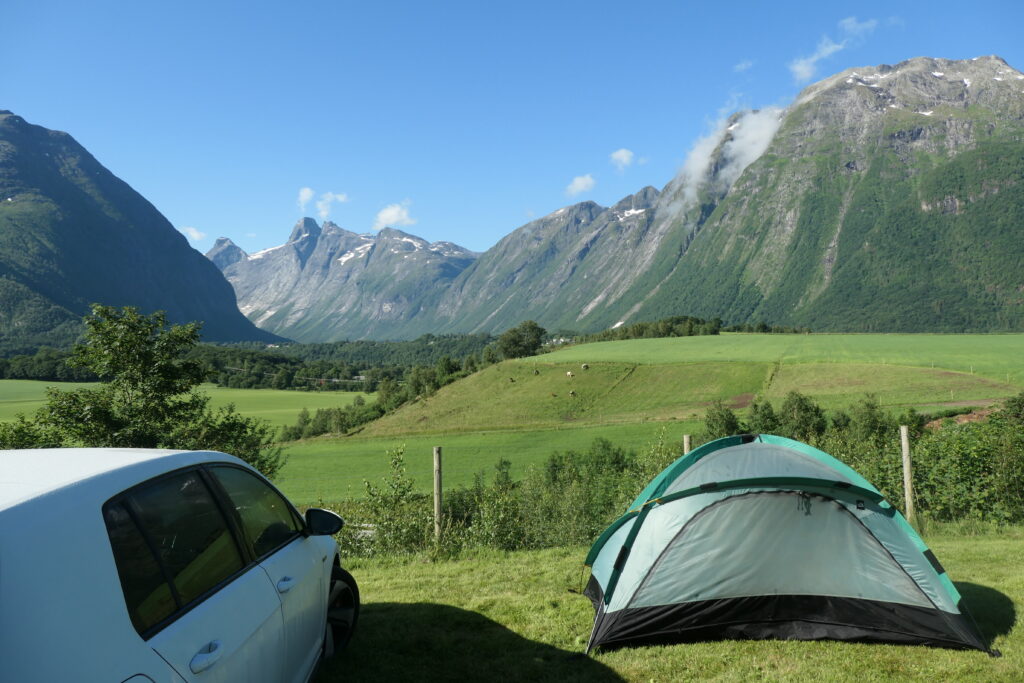





Arctic Circle centre
The Arctic Circle centre, located in Saltfjellet, Norway, is a popular tourist destination for anyone crossing the Arctic Circle. Located on the E6 highway, the centre offers visitors a chance to learn about the unique environment and culture of the Arctic region. It features exhibits on the northern lights, wildlife, and Sami traditions.
The car park at the centre is often filled with camper vans, as it’s a well-known stop for road travelers exploring the Norwegian Arctic. Many visitors use the site as a base to rest, enjoy local cuisine, and marvel at the stunning landscapes surrounding the area.
When we were there we were excited to experience 24 hour daylight!


Bardufoss
Bardufoss is a small town located in Målselv Municipality in Troms County, Norway. Situated near the base of the picturesque Bardufoss mountain, it is known for its stunning natural surroundings, including forests, rivers, and fjords. It’s also close to the northernmost part of the Lyngen Alps, making it a prime location for anyone looking for adventure in Arctic landscapes.


Bognes
Bognes is a ferry port on the western side of the Tysfjorden, in north western Norway. You can catch the ferry to either Lodingen on the Lofoten islands or Skarberget in Narvik. The ferry ports are adjacent to each other, so be careful which you go to 😉

Borlaug
Borlaug is a small village that sits at the top of the Lærdalsdalen valley, located in the municipality of Årdal, in the Sogn og Fjordane region of western Norway. Nestled between dramatic fjords and mountains, the village offers stunning natural beauty, and is a popular hiking spot.
It lies on the Filefjell Kongevegen (the Kings road), which is the historical main route linking western and eastern Norway. The Kings road is the name of the old trail over Filefjell, the mountainous area between Borlaug and Valdres in central southern Norway.
The village itself has a long history tied to local farming traditions, and is known for its picturesque landscapes, including lush valleys and the nearby Årdalsfjord. Unfortunately when we were there it was raining and covered in mist. That said, it was clear to see the potential of the area, for nest time we visit.
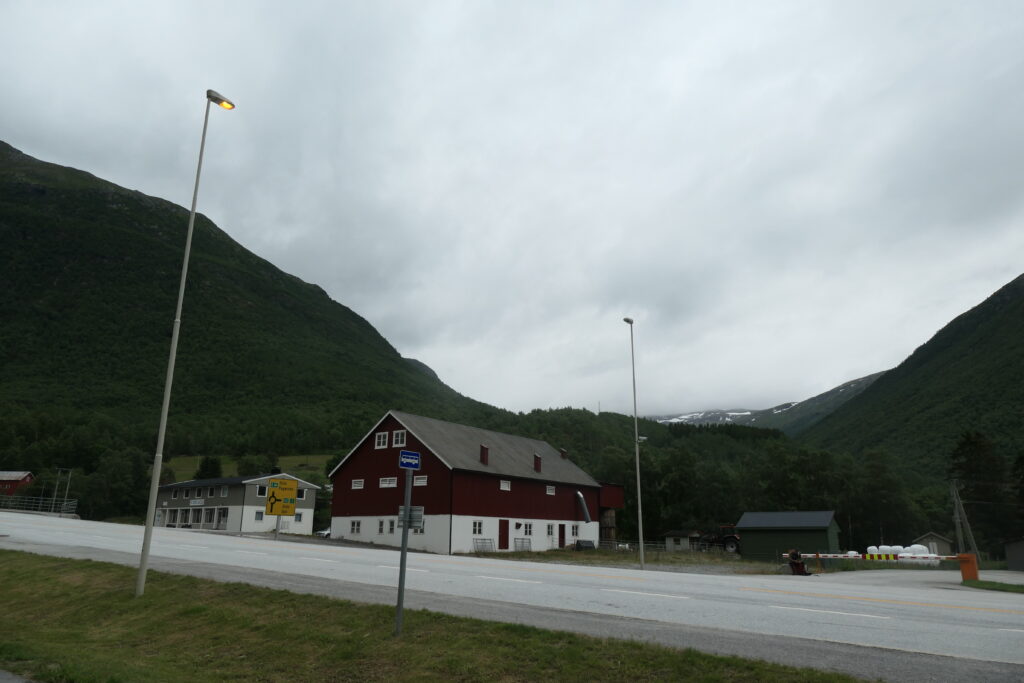



Børtnes
Børtnes is located in central southern Norway, on the Hallingsdaselva river, known locally as the Great River due to its many hydro-electric power stations in the valley.


Bøyabreen Glacier
Bøyabreen Glacier is a fantastic, easily accessible glacier that’s located near to the Glacier museum in south west Norway. There’s a viewpoint at road level, and although you’re not close enough to touch the glacier, the views are great.
The glacier is actually part of the biggest glacier in mainland Europe, Jostedalsbreen, and is located inside Jostedalsbreen National Park.


Dalsnibba
Mount Dalsnibba, located in Norway, is a stunning peak that rises 1,476 meters (4,843 feet) above sea level. It offers panoramic views of the surrounding landscapes, including the famous Geirangerfjord. A popular destination for tourists, the mountain is accessible via the Dalsnibba Skywalk, a scenic road that leads to a viewpoint offering breathtaking vistas of snow-capped peaks, lush valleys, and sparkling waters below.
Mount Dalsnibba is part of the UNESCO World Heritage-listed Geirangerfjord area, and at its base is the lovely Djupvatnet lake.


Eidsvatnet

Eidsvatnet is a picturesque lake located in the municipality of Gulen, in western Norway. Surrounded by lush green landscapes and steep mountains, the lake offers a peaceful and serene setting.
The whole area is a hidden gem for nature lovers, with its clear waters and stunning backdrop of rugged terrain. Its proximity to the popular Sognefjord region makes it a great stop for anyone seeking a tranquil, scenic spot to relax and enjoy the beauty of Norway’s fjords and mountains.
Fodnes
Fodnes is a busy ferry port on the Sognefjord, in the south west of Norway. The views across the fjord are amazing!
The ferry travels all day between Fodnes and Mannheller, a distance of about 1¾ miles (2¾ km), and talked about 15 minutes. Apparently, in 2022, the ferry transported a total of 779,122 vehicles, averaging around 2,135 vehicles per day. The ferry price is 86 NOK (around £6) for a car (2024).
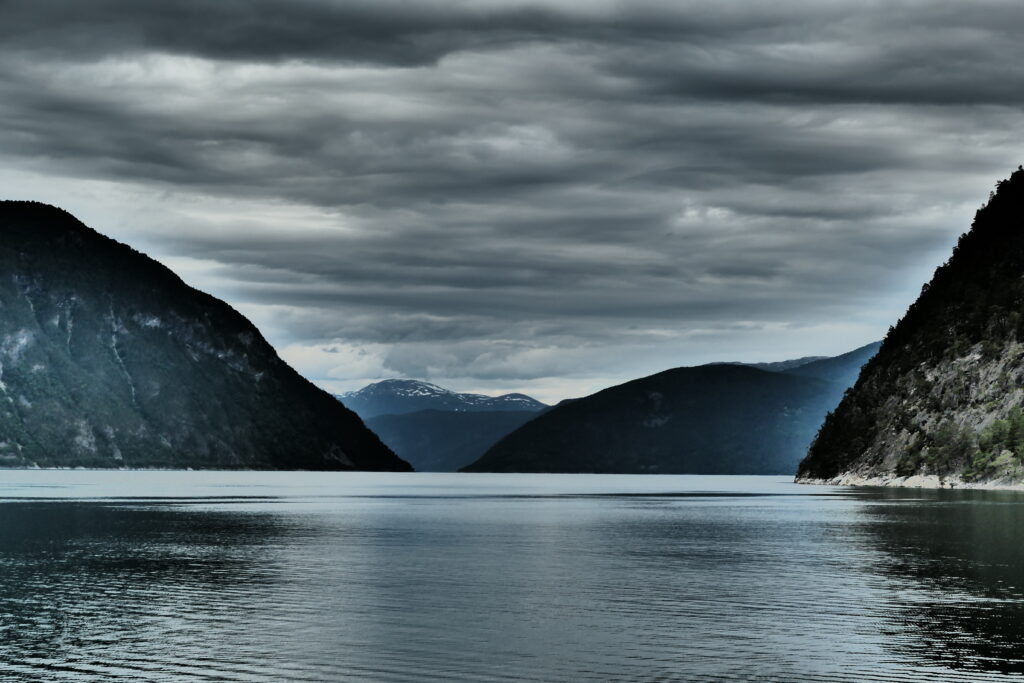





Fustvatnet
Lake Fustvatnet is a picturesque lake located in Vefsn Municipality, in the Nordland region of Norway. Covering an area of approximately 8½ square miles (22 square km), it sits at an altitude of 262 ft (80 m) above sea level. Known for its clear, turquoise waters, the lake is surrounded by rugged landscapes, including forests and mountains. Fustvatnet is a popular destination for outdoor activities such as fishing, hiking, and kayaking. Its scenic beauty, combined with the tranquil atmosphere, makes it a favorite spot for nature lovers.


Geiranger
Geiranger is a small but incredibly tourist village in the south west of Norway, due to the stunning beauty of the whole area. Huge cruise ships regularly visit the Geirangerfjord and the village, whilst thousands of people descend on it from the beautiful mountain roads, some of which provide sensational views.
Because the village offers such dramatic views of steep cliffs, lush valleys, and cascading waterfalls, such as the Seven Sisters and the Bridal Veil, it’s a must-visit for those exploring Norway’s spectacular fjords.



Glacier museum
The Glacier museum is located in a beautiful valley in Fjærland in south west Norway. Its main focus is on the Jostedalsbreen glacier, that’s located in the surrounding Jostedalsbreen National Park.
It provides captivating exhibits on glacial geology, the history of ice formations, and their impact on the environment. Interactive displays, educational films, and informative panels make it a great stop for anyone interested in nature, climate change, and the unique landscapes of Norway. With its stunning location and wealth of knowledge, the museum is an essential visit for travelers exploring Norway’s fjords and glacial wonders.






Halden Canal
The Halden Canal is located in south east Norway, and runs parallel to the border with Sweden. Due to having four locks, some pretty major boats can travel quite far inland, all the way to Skulerud. There are quite a few stopping places along the canal, offering great places to stop and have a break, whilst admiring the lovely views.


Heimsjøen
Heimsjøen is a lake in Snasa, Trøndelag in central Norway. The lake was incredibly clam, and provided some good reflections when we were there. The area is popular with hikers and runners alike.


Hodndalen
Hodndalen lies on the Filefjell Kongevegen (the Kings road), which is the historical main route linking western and eastern Norway. The Kings road is the name of the old trail over Filefjell, the mountainous area between Borlaug and Valdres in central southern Norway. It’s a picturesque area with plenty of hiking routes. It sits beside the Lærdalselvi river, which was traditionally known as one of the most exclusive salmon and sea trout fishing rivers in the country.
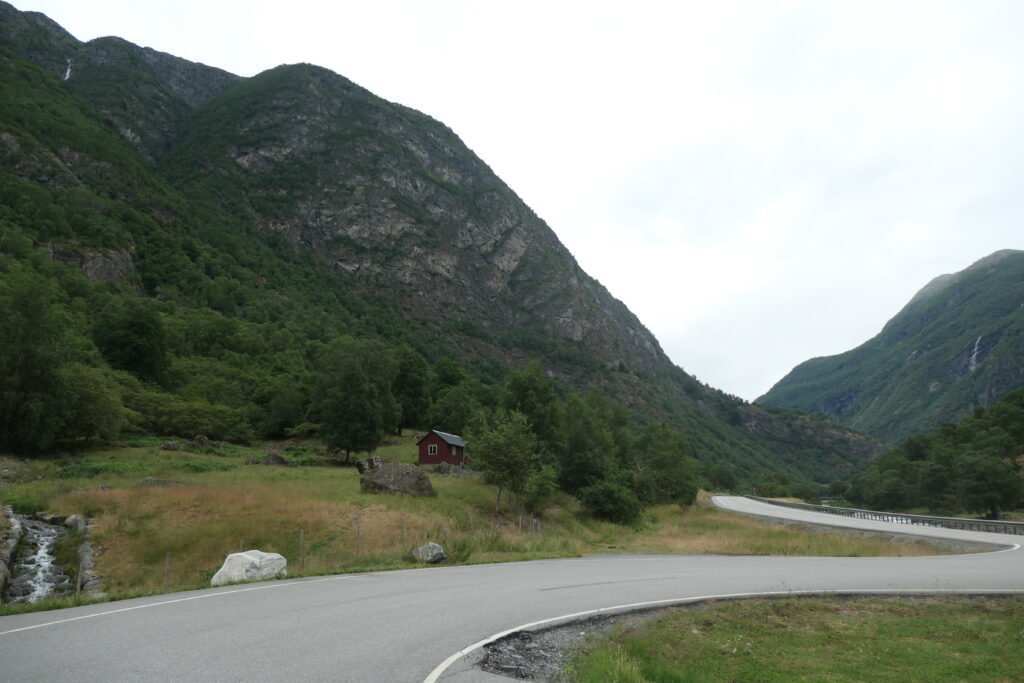

Hønefoss
Hønefoss is a non-touristy town in south eastern Norway that we visited to give us a sense of how Norwegians actually live, when they’re not being overwhelmed by never-ending trains of camper vans! 😉 Surprisingly we found one of the few places in the country where few speak spoke English!


Inderøy
Inderøy is a picturesque municipality in central Norway, located in the Nord-Trøndelag region, known for its stunning landscapes of rolling hills, fjords, and charming rural villages. The area is perfect for hiking, fishing, and exploring the scenic coastal views.
We stayed at the Sund Sommerhotell near the Trondheim fjord. It’s an historic hotel offering a serene escape with breathtaking views of the surrounding nature. We liked it, it reminded us of being back at university! When we were there, an international group of musicians were on site.







Innhavet
Innhavet is a picturesque village located in Hamarøy Municipality, Nordland County, in central Norway. Sitting besides the the scenic Sagfjorden, it serves as a gateway to both the Lofoten Islands and Nordkapp when travelling north, and the Arctic Circle when travelling south. With its stunning natural surroundings, Innhavet is surrounded by fjords, mountains, and lush landscapes, making it a popular spot for outdoor activities such as hiking, fishing, and wildlife viewing.

Innvikfjord
Innvikfjord is a stunning arm of the larger Nordfjord in south western Norway, known for its breathtaking landscapes and peaceful ambiance. It’s around 2¾ miles (4½ km) in length, and is named after the village of Innvik, which sits on the fjord.
Surrounded by towering mountains, lush green hillsides, and traditional Norwegian farms, the fjord offers an incredible natural setting. The waters are perfect for kayaking, fishing, and cruising, and provide serene views of the surrounding scenery. It’s an ideal destination for those seeking an authentic and peaceful Norwegian experience.
When we were there we were welcomed not only by goats , but also by cows! 😉




Kåfjord
Kåfjord is a picturesque village in the Nordkapp municipality of Norway, located in the far northern part of the country. Nestled along the coast of the Barents Sea, it offers breathtaking views of the surrounding fjords and rugged landscapes. Kåfjord is known for its historical significance, particularly its role in the mining industry during the 19th and early 20th centuries.
Today, it serves as a gateway for anyone exploring Nordkapp (North Cape), one of Europe’s northernmost points, and is close to the Nordkapp tunnel. The region is also celebrated for its unique Arctic wildlife and dramatic scenery, making it a popular spot for nature enthusiasts.


Kaupanger
Kaupanger is an old viking village on the Sognefjord, in the south west of Norway. It has a population of just over 1,000 people (2019). We found a great little campsite right on the fjord with fantastic views – Amlasden Fjordcamping.
It’s surrounded by towering mountains and lush forests, and is great for hiking, boating, and scenic drives. Its peaceful atmosphere and proximity to the world-famous fjords make it a perfect spot to use as a base for exploring Norway’s captivating landscapes and culture.
The Sognefjord is the longest and deepest fjord in the country, at a depth of 4,291 ft (1,308 m) below sea level. The fjord stretches 127 miles (205 km) inland from the ocean, and is about 3½ miles (6km) wide. The amazing cliffs that surround the fjord rise to heights of around 3,300 ft (1km).






The King’s view / Kongens Utsikt
The King’s view is a simply incredible viewpoint on the top of a mountain in Sundvolden, south east Norway. Not for the faint hearted, it’s definitely challenging, as it’s so steep from the outset. It’s about 4 miles (6 km) in length there and back. After 1 mile (1½ km) or so of steep uphill from the outset at the Sundvolden Hotel, it mostly levels out at the top of the mountain, leading to a viewpoint that is simply beautiful – a MUST SEE! Getting back down enables you to discover muscles in your legs and hips that you didn’t know you had – unless you’re super fit of course!










Lærdalsøyri
Lærdalsøyri is located on the Sognefjord, in the south west of Norway. Although it only has a small population of around 1,100 people (2019), it’s very busty with tourists who come to visit its heritage city center, with its hundreds of beautiful wooden houses that date from the 18th century.


Lodingen
Lødingen is a small ferry town located on the mainland side of the Lofoten Islands in Nordland County, north western Norway. Situated at the entrance to the beautiful Vestfjord, Lødingen is known for its breathtaking natural landscapes, including mountains, fjords, and coastlines. It serves as a gateway to the Lofoten Islands, providing ferry connections to Bognes. The town is rich in history, with roots dating back to the Viking Age, and offers a peaceful atmosphere.


Lofoten Islands
The Lofoten Islands are an archipelago located in northern Norway, within the Arctic Circle, and are known for their dramatic and rugged geography. The islands are characterized by steep, jagged mountains, deep fjords, and sheltered bays, creating a stunning, varied landscape. The highest peaks, such as Mount Svolværgeita and the surrounding mountains, rise sharply from the sea, offering striking vistas.
Lofoten is made up of several large islands, including Austvågøy, Vestvågøy, Flakstadøy, and Moskenesøy, with numerous smaller islands in between. The islands are interspersed with long, narrow fjords, such as the famous Reinefjord, and surrounded by the waters of the Norwegian Sea.
The climate in Lofoten is milder than one might expect for its latitude, thanks to the Gulf Stream, which helps warm the area despite its northern location. This unique geography allows for a diversity of ecosystems, from lush forests and wetlands to alpine tundra. The coast is dotted with picturesque fishing villages like Reine and Henningsvær, often built on stilts in the water, making the Lofoten Islands a fascinating blend of natural beauty and human settlement.
The Lofoten Islands really are one of the most stunning destinations in Norway, and they’re definitely worth visiting. If you’re into outdoor adventures like hiking, kayaking, or fishing, or simply want to enjoy the scenery, Lofoten should definitely be on your list of places to go.










Lyngen Alps
The Lyngen Alps are a stunning mountain range located in Troms County, northern Norway, known for their dramatic, rugged beauty. The mountains rise sharply from the fjords, creating a striking landscape of jagged peaks, deep valleys, and glaciers. They’re often described as some of the most scenic mountains in Norway, with their steep, snow-covered slopes and striking contrasts between the dark rock faces and the white of the snow.

Nesbyen
Nesbyen is a picturesque town of around 3,300 people (2024), located in central southern Norway, on the Hallingsdaselva river, known locally as the Great River due to its many hydro-electric power stations in the valley.
Nestled in the heart of Norway, Nesbyen is a hidden gem that offers a perfect blend of natural beauty and outdoor adventure. Located in the scenic Hallingdal Valley, this charming village is surrounded by lush forests, rivers, and rolling hills. Whether you’re into hiking, cycling, or skiing, Nesbyen provides year-round opportunities for outdoor enthusiasts. In winter, it transforms into a snow lover’s paradise, while summer brings vibrant greenery and clear skies for hiking trails. With its peaceful atmosphere, rich culture, and easy access to nearby attractions, Nesbyen is the ideal destination for an authentic Norwegian escape.


Nordkapp
Nordkapp, or North Cape, is a famous point located on the northernmost tip of the European mainland in Norway. Situated in the Finnmark region, it stands (1,007 ft) 307 m above the Arctic Ocean, offering breathtaking views of the midnight sun in summer and the Northern Lights in winter. The site is a popular tourist destination, attracting over 200,000 visitors annually (2023). There’s also a visitors centre with a globe monument that’s very popular with photographers. When we visited, there was a queue to get in to the free car park!





Nordmannset
Nordmannset is a small village in Norway, located in the Nordland region, known for its breathtaking natural landscapes and proximity to Sami culture. The area is home to the indigenous Sami people, who have a rich history and strong ties to the land. Traditionally, the Sami have lived as reindeer herders, and their cultural influence is still evident in the region today. Visitors to Nordmannset can learn about Sami traditions, including their language, crafts, and music. The village also offers stunning views of the surrounding mountains and fjords, providing an immersive experience of both nature and Sami heritage.


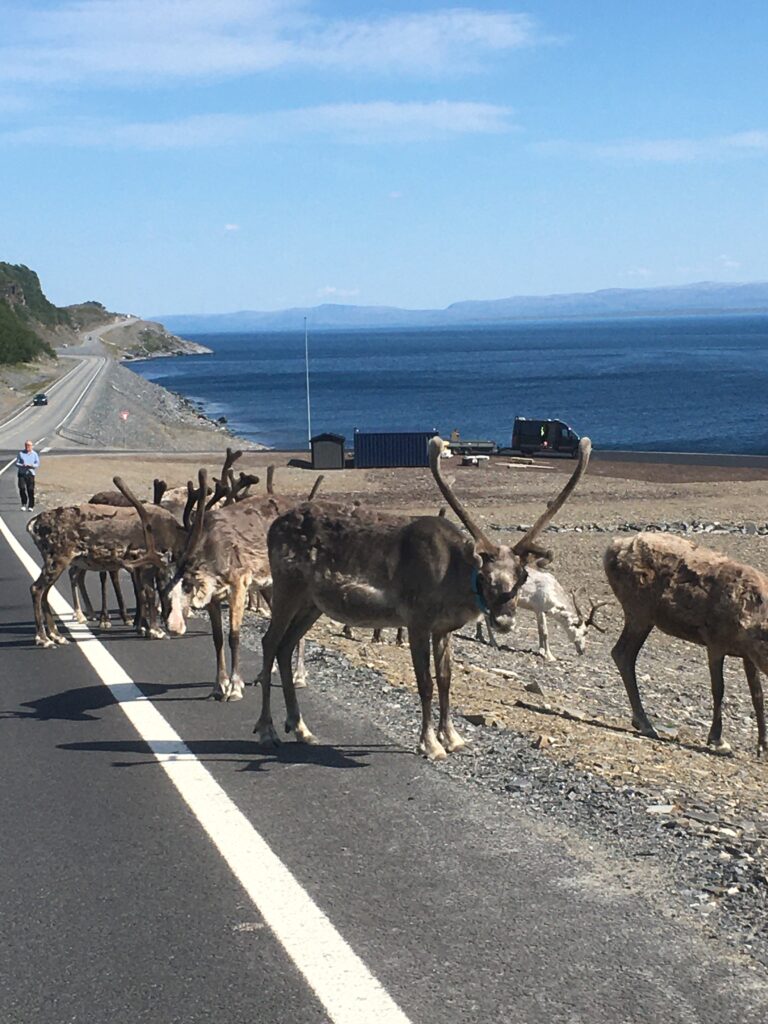

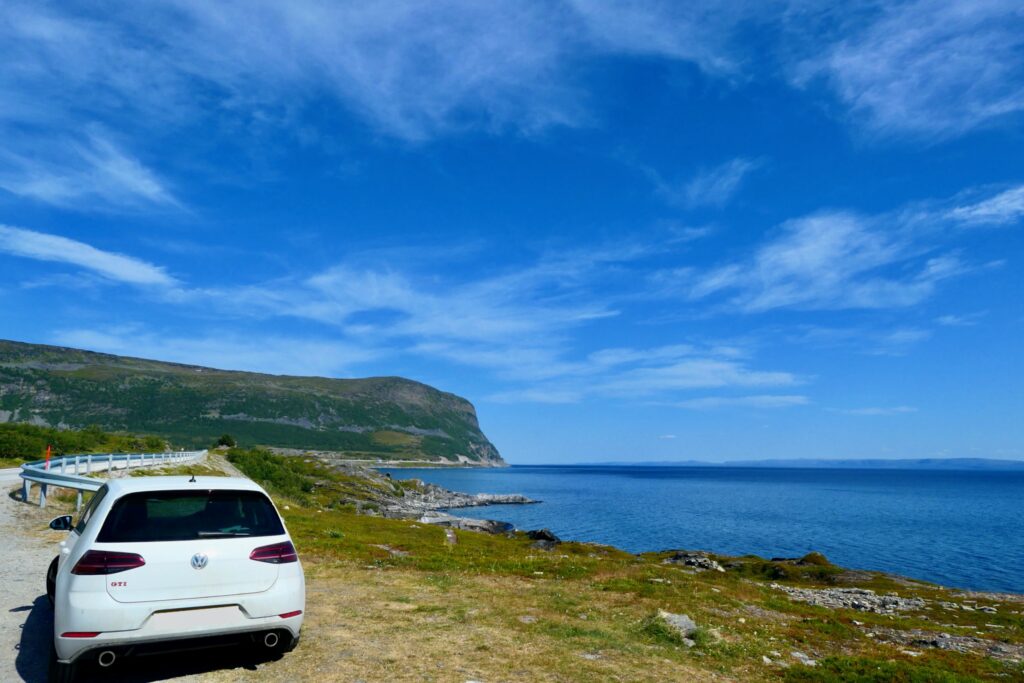
Rognan
Rognan is a small, pretty village of a couple of thousand people on the banks of the Saltdal Fjord. The fjord is around 7 miles (11 km) long, and is part of the larger Skjerstad Fjord.


Røkland
Røkland is a small village just north of the arctic circle, located along the Saltdalselva river. The village is nestled between stunning mountains and lush landscapes, and is a really peaceful setting for anyone exploring northern Norway. We stayed at the Nordnes Campsite, which offers a serene environment with picturesque views of the surrounding nature, making it an ideal place for camping, hiking, and fishing. It makes a perfect base for anyone wishing to explore the area.


Rovijokfossen
Røvikjofossen is a stunning waterfall located in remote north east Norway. You can hear the waterfall long before you can see it, as it’s surrounded by steep woodland and rugged terrain, meaning that it’s not the easiest to get to. You end up scrambling down beside the waterfall, as it cascades dramatically over the steep cliff. It really is a great site, and at the base of the waterfall is a small beach area and lovely river.





Sarnes
Sarnes is a small village located in the Nordland region of Norway, offering picturesque views of the surrounding fjords and mountains. Situated in an area with a rich cultural history, Sarnes is closely linked to the Sami people, the indigenous population of the Arctic region. The Sami have lived in this part of Norway for centuries, with a deep connection to the land, particularly through reindeer herding. Visitors to Sarnes can experience traditional Sami culture, including their crafts, music, and language.



Smørfjord
Smørfjord is a scenic village located in the municipality of Loppa in Norway’s Finnmark region. Nestled along the beautiful coastline, it offers stunning views of the Arctic Ocean, mountains, and surrounding fjords. Historically, Smørfjord was an important fishing village, with the local economy relying on the rich marine life of the area. Today, it remains a quiet, remote place, attracting visitors who seek to experience authentic Norwegian coastal life. The village is also a gateway to exploring the rugged natural beauty of the region, with opportunities for hiking, wildlife spotting, and immersing in Sami culture.


Stabburneses
Stabbursnes is a picturesque location in Norway, situated in the northern part of the country, near the Stabbursdalen National Park in Finnmark. Known for its stunning natural beauty, it offers visitors breathtaking views of lush valleys, mountains, and the Stabburs River. Stabbursnes is also home to the Stabbursnes Nature Reserve, which is famous for its ancient, untouched landscapes and diverse wildlife. We camped in the Stabbursdalen resort, which is a great place to use as a base.





Stardalselva Valley
The Stardalselva Valley, located in Norway’s scenic Sogn og Fjordane region in south western Norway, is a hidden gem offering stunning natural beauty and tranquility. The valley is home to the Stardalselva River, which winds its way through lush landscapes, surrounded by steep mountain slopes and dense forests. The whole area is perfect for hiking, fishing, and photography, with breathtaking views at every turn. The valley is also known for its rich wildlife, offering opportunities to spot local fauna in their natural habitats.


Stranda
Stranda, located near Nordkapp in Norway, is a small village in the Finnmark region, offering stunning views of the Arctic landscape. Known for its natural beauty, Stranda is a peaceful place surrounded by rugged terrain, including dramatic cliffs and the Arctic Ocean. While it is not as well-known as other destinations in the region, its proximity to Nordkapp, the northernmost point of Europe, makes it an ideal stop for anyone seeking to explore this unique part of the country.


Sundvolden
Sundvolden is a small village in south east Norway, that’s home to Norway’s oldest hotel of the same name. The hotel dates from the 17th century and is excellent, we highly recommended it. In addition, right next door is the King’s View hike and viewpoint.
Just an hour’s drive from Oslo, Sundvolen is situated near the picturesque Krøderen Lake, and is surrounded by serene lakes and lush forests, offering outdoor activities like hiking, fishing and skiing.
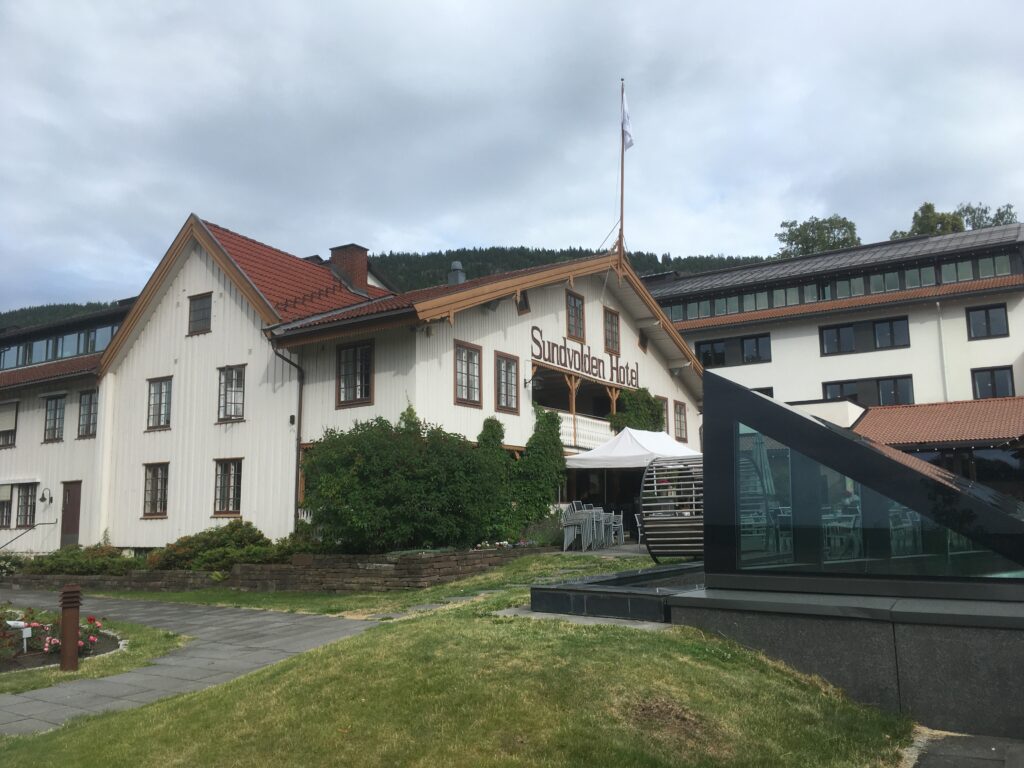

Svensby
Svensby is a small village located in the municipality of Tromsø in Troms County, Norway. Situated on the island of Kvaløya, Svensby lies along the shores of the picturesque Balsfjorden, offering stunning views of the surrounding mountains and fjords. The village is known for its tranquil atmosphere and beautiful natural surroundings, making it a peaceful spot for nature lovers and outdoor enthusiasts.
We stayed in the excellent Svensby Tursenter camp site, which has excellent views and is highly recommended.








Trollstigen
Possibly one of the best roads in the world? Definitely up there with the mountains passes in Switzerland and Austria! It takes you from the Geiranger fjord right the way through a cascade of fantastic view posts to Åndalsnes.
The Troll Road, or Trollstigen, is one of Norway’s most famous and scenic routes, winding its way through the dramatic mountains of the Romsdalen Valley. This iconic road, part of the Norwegian National Tourist Routes, is renowned for its hairpin bends and steep ascents, offering jaw-dropping views of lush valleys, cascading waterfalls, and towering peaks.
Opened in 1936, Trollstigen is a thrilling drive, with a high-altitude viewpoint offering panoramic vistas. There are several dramatic waterfalls, and the road is particularly popular with travellers in summer, providing access to nearby attractions like Geirangerfjord and Åndalsnes. It’s a must-see for those seeking an unforgettable Norwegian adventure.















Trollstigen camp site
Trollstigen camp site is located on the Troll road, and provides a source of amusement for all and sundry with its collection of large trolls. We’ve not stayed at the campsite, but the café is quite good for a break.




Ulvsvåg
Ulvsvåg is a small village located in Hamarøy Municipality, Nordland County, Norway. Situated on the shores of the scenic Ulvsvåg Bay, it overlooks stunning views of Tannøya island and the surrounding fjords and mountains. The village is a popular stop for anyone on their way to the Lofoten Islands, and it’s an ideal destination for anyone looking to experience authentic coastal landscapes and the charm of rural Norwegian life.


Valldalen
Valldalen is a valley to the north of the beautiful Norddalsfjorden, in the south west of the country. the valley runs from Sylte to Trollstigen. It’s a picturesque and serene destination renowned for its stunning natural beauty. Nestled between towering mountains and lush, green landscapes, the valley is famous for its idyllic views of crystal-clear rivers, rolling meadows, and traditional Norwegian farms.
The valley is also a haven for outdoor enthusiasts, offering activities like hiking, fishing, and skiing in winter. The whole area is also known for its vibrant agricultural culture, particularly its delicious local produce, such as berries and apples. Valldalen provides an authentic escape into Norway’s tranquil countryside, making it an ideal spot for nature lovers.


What’s it like to drive in Norway?
Anyone want to drive a camper around Norway?
Driving in Norway is a sedentary affair due to having to stop and marvel the wonders that surround you 🙂 It’s also very slow moving traffic due to the unbelievable amount of camper vans of all varieties that are on the road. Sometimes you’ll find yourself in a slow moving queue of over a hundred vehicles!
At the arctic circle, the car park was so full of campers that it looked that a show ground for them!
The Middle of Norway
Whilst Norway’s south western fjords and the coastline are spectacular, we found that we particularly like the E6 road that travels up through the centre of the country. It was mostly quieter and was peppered with scenic lakes and forests that were great for finding pleasant spots for a break or a snack.
Sooner or later you’ll also come across some reindeer on the road, which is always a great sight!



Boring Norwegian roads
Whaaat! There are boring roads in Norway? I know, it’s difficult to believe, but we found one that’s not spectacular anyway! Only one, mind you 🙂
It’s the E45 between Aidejavri, on the border with Finland, and Badje Máze. To be honest though, we’ve just been spoilt by all the other outstanding roads in Norway!



Electric cars in Norway
Norway is electric car heaven too! There are loads of electric cars in Norway and the charging network is very extensive – I guess that’s what wealth and demand does for you!
Do you require an international driving permit in Norway?
We’ve created a dedicated page to driving abroad, which answers this question, and more, which you might find helpful.
Can you use your UK driving license when driving through Norway?
We’ve created a dedicated page to driving abroad, which answers this question, and more, which you might find helpful.
Do I need a carnet de passages to drive in Norway?
We’ve created a dedicated page to driving abroad, which answers this question, and more, which you might find helpful.
What are the speed limits in Norway?
As with almost everywhere on the continent of Europe, they drive on the right hand side of the road in Norway.
The speed limits for cars in Norway are:
- 30 mph (50 km/h) for urban driving
- 50 mph (80 km/h) outside of built up areas
- 55 mph (90 km/h) on dual carriageways
- 60 mph (100 km/h) on motorways
What currency do they use in Norway?
In Norway they use the Krone. The use of credit / debit cards is now widespread, although not guaranteed – have some cash just in case, particularly in cafés and restaurants and some smaller supermarkets. Travellers cheques are accepted in major cities. There are lots of ATMs.
You should make yourself aware of the amount that your bank charges you for using credit and debit cards abroad. Often credit cards are cheaper for purchasing items directly, and for withdrawing cash from ATMs.
What language do they speak in Norway?
They speak Norwegian in Norway, although more than 9 in 10 people can also speak fluent English. German, Spanish and French are also spoken, although to a much lesser extent.
What time zone is Norway in?
Remember, when you’re planning your next trip to take a look at what time zone it’s in.
Do I need a visa to visit Norway?
We’ve created a dedicated, more comprehensive page on visas, which you should find helpful. Check it out!
Is wild camping legal in Norway?
Yes, wild camping is fine in Norway.
What plug / socket type do they use in Norway?

In Norway they use plug / socket type F.
Health issues in Norway
Is it safe to drink water in Norway?
Yes, it is safe to drink tap water in Norway. Bottled water is also readily available across the country.
What vaccinations are required for Norway?
This NHS website is kept up to date with all relevant information on vaccinations in Norway.
Phones in Norway
What is the country calling code for Norway?
The country calling code for Andorra is +47
What are the emergency phone numbers in Norway?
- The emergency number for police in Norway is: 112
- In Norway, the emergency number for ambulance is: 113
- The emergency number for fire in Norway is: 110
If you’ve got some useful info that you’d like to share, let us know!
Don’t forget to check out all the other pictures!
